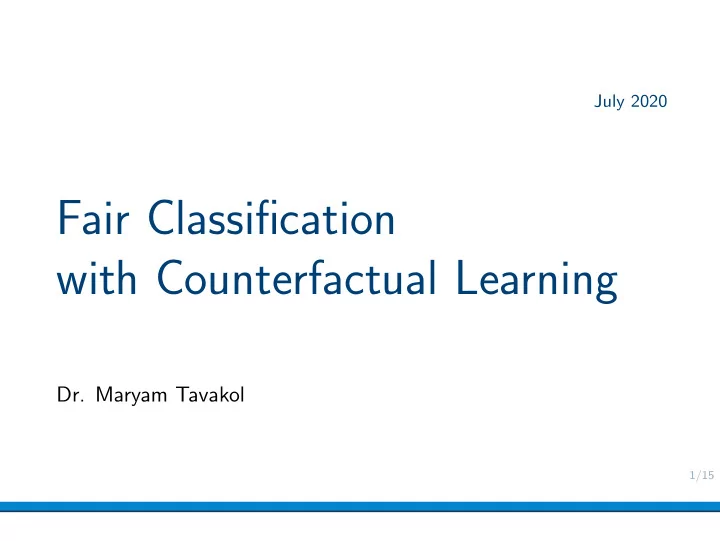

July 2020 Fair Classification with Counterfactual Learning Dr. Maryam Tavakol 1/15
What is Fairness 2/15
ML/DM Basics Collecting the data (pre-processing, cleaning, etc.) Learning a model that fits the data (optimizing an objective) 3/15
The Role of Biases *Adult income data 4/15
Fairness-aware Learning Why: to have more responsible AI and trustworthy decision support systems that can be used in real life Goal: to develop models without any discrimination against individuals or groups, while preserving the utility/performance 5/15
Fairness-aware Learning How: Define fairness measures/constraints Alter the data/learning/model to satisfy fairness Evaluate the model for balancing performance vs. fairness 6/15
Definition of Fairness Equalized Odds: both protected and non-protected groups should have equal true positive rates and false positive rates P (ˆ y = 1 | s = 0 , y ) = P (ˆ y = 1 | s = 1 , y ) , y ∈ { 0 , 1 } s is a binary sensitive attribute 7/15
Learning Framework ML/DM methods often depend of factual reasoning Alternatively: counterfactual methods learn unbiased policies from logged bandit data via counterfactual reasoning 8/15
Learning Framework ML/DM methods often depend of factual reasoning Alternatively: counterfactual methods learn unbiased policies from logged bandit data via counterfactual reasoning Connect two concepts: to design non-discriminatory models by learning unbiased policies in counterfactual settings 8/15
Counterfactual Bandits treatments A B C outcome patient 1 1 � patient 2 1 × patient 3 1 × patient 4 1 � ... ... ... patient n 1 × 9/15
Counterfactual Bandits treatments A B C outcome patient 1 1 1 ? patient 2 1 × patient 3 1 × patient 4 1 � ... ... ... patient n 1 × 9/15
Counterfactual Bandits treatments A B C outcome patient 1 1 1 ? patient 2 1 × patient 3 1 × patient 4 1 � ... ... ... patient n 1 × Goal: learn a policy to optimize the outcome 9/15
Counterfactual Learning (cont.) Goal: to find an optimal policy π ∗ which minimizes the loss of prediction on offline data 1 Evaluation: estimate the loss of any policy (unbiased) R ( π ) = E x E y ∼ π ( y | x ) E r [ r ] 2 Learning: optimize the objective π ∗ = arg min π ∈ Π [ R ( π )] 10/15
Fairness in Counterfactual Setting Idea: turn the biased (unfair) classification into the task of learning from logged bandit data class label y = 0 y = 1 is fair 1 � x 1 1 × x 2 1 � x 3 ... ... ... ... 1 × x n 11/15
Fairness in Counterfactual Setting Idea: turn the biased (unfair) classification into the task of learning from logged bandit data class label y = 0 y = 1 is fair extendable to 1 � x 1 multi-class 1 × x 2 classification 1 � x 3 ... ... ... ... 1 × x n 11/15
Sampling Policy The true class labels are the sampling (unfair) policy π 0 – known & deterministic We aim at re-labelling the samples in order to additionally satisfy fairness – learn π ∗ 12/15
Sampling Policy The true class labels are the sampling (unfair) policy π 0 – known & deterministic We aim at re-labelling the samples in order to additionally satisfy fairness – learn π ∗ Therefore, π 0 is (re-)estimated as a stochastic policy to identify the decisions with low probability later used in characterizing the feedback 12/15
Reward Function Recall equalized odds P (ˆ y = 1 | s = 0 , y ) = P (ˆ y = 1 | s = 1 , y ) , y ∈ { 0 , 1 } In order to satisfy fairness measure, find k such that � n � n i =1 ✶ { y i = 1 ∧ s i = 1 } + k i =1 ✶ { y i = 1 ∧ s i = 0 }− k = � n � n i =1 ✶ { s i = 1 } i =1 ✶ { s i = 0 } 13/15
Reward Function (cont.) B + k : set of k positive samples from non-protected group ( s = 0) with lowest sampling probabilities, ˆ π 0 ( y = 1 | x ) B − k : set of k negative samples from protected group ( s = 1) with lowest sampling probabilities, ˆ π 0 ( y = 0 | x ) � i ∈ { B + k ∨ B − 0 k } r i = − 1 otherwise penalize k most-likely unfair decisions from each group 14/15
Summary of the Approach 1 Learn a stochastic sampling policy from a fraction of data 2 Convert the classification data into bandit data 3 Compute bandit feedback from fairness measure (other definitions or their combination also possible) 4 Learn a counterfactual policy that trades-off classification performance vs. fairness In practice: our model effectively increases a measure of fairness while maintains an acceptable classification performance 15/15
Recommend
More recommend